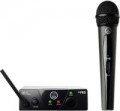Number in set
Number of microphones included in delivery.
In fact, situations are quite frequent when it is necessary to use several microphones at the same time. This is most often associated with the participation of several people — for example, two presenters on stage — but there are also more specific moments, for example, stereo recording with 2 microphones using a special mount. For all such situations,
kits are produced that include more than 1 microphone (actually, in our catalog the number is indicated only if there are more than one microphone in the kit). In the most extensive sets, this number can reach 8.
Directional pattern
The polar pattern of a unidirectional microphone (see above). There are models with
DN switching.
By itself, such a diagram is a graph of sensitivity versus direction, built in the so-called polar coordinate system. For unidirectional models, there are three main options for the shape of the line on such a chart:
—
Cardioid. A chart shaped like an inverted heart symbol (hence the name). Microphones with these characteristics cover a fairly large area in front, which makes it difficult to filter out extraneous sound sources that are close to the main source. At the same time, they are completely insensitive to sound coming from the rear.
—
Supercardioid. These mics have a narrower front coverage than "classic" cardioid mics, making it easier to pick up directional sound. The downside of this is some (albeit rather low) sensitivity to sound coming directly from behind.
—
Hypercardioid. The hypercardioid pattern further narrows the microphone's sensitivity zone in the front (compared to the supercardioid pattern), but widens this zone in the back.
Frequency range
The range of audio frequencies normally perceived and processed by a microphone.
The wider this range — the fuller the signal, the less likely that too high or low frequencies will be missed due to the imperfection of the microphone. However, in this case, it is worth considering some nuances. First of all: a wide frequency range in itself does not guarantee high sound quality — a lot also depends on the type of microphone (see above) and its frequency response, not to mention the quality of other components of the audio system. In addition, a large width is also not always really necessary. For example, for normal transmission of human speech, a range of 500 Hz — 2 kHz is considered sufficient, which is much narrower than the general range perceived by the human ear. This general range, in turn, averages from 16 Hz to 22 kHz, and also narrows with age. Do not forget about the features of the equipment to which the microphone is connected: it is hardly worth specifically looking for a model with an extensive range, if, for example, the amplifier to which it is planned to be connected severely “cuts off” the frequencies from above and/or below.
Sensitivity
Sensitivity describes the signal strength at the output of a microphone when it processes a sound of a certain volume. In this case, sensitivity means the ratio of the output voltage to the sound pressure on the membrane, expressed in decibels. The higher this number, the higher the sensitivity. Note that, as a rule, values in decibels are negative, so we can say this: the closer the number is to zero, the more sensitive the microphone. For example, a -38 dB model outperforms a -54 dB model in this parameter.
It should be borne in mind that high sensitivity in itself does not mean high sound quality - it only allows the device to “hear” a weaker sound. Conversely, low sensitivity is not an unequivocal sign of a bad microphone. The choice for this parameter depends on the specifics of the application: a sensitive device is useful for working with low sounds and in cases where it is necessary to capture the smallest nuances of what is happening, and a “weak” microphone will be convenient at high sound volume or, if necessary, filter out extraneous weak noises. There are models with
sensitivity adjustment(and for models with a headphone output
, headphone volume control may be provided).
Signal to noise ratio
A parameter that describes the relationship between the useful signal level and the noise level produced by the microphone. Note that the actual signal-to-noise ratio varies depending on the sound pressure perceived by the microphone. Therefore, in the characteristics it is customary to indicate the option for a standard situation — at a sound pressure of 94 dB. This allows you to compare different models with each other.
In general, this indicator quite clearly characterizes the quality of work of a particular model, since it takes into account almost all significant extraneous noise that occurs during operation. The greater this ratio, the clearer the sound is, the less distortion it has. Values of 64 – 66 dB are considered quite decent, and high-end microphones provide performance of 72 dB and higher.
LCD display
The presence of its own LCD display in the design of the microphone. This, usually, is the simplest single-colour matrix, sometimes even of a segment type (as in an electronic watch, where the characters on the display are made up not of pixels, but of individual segments). At the same time, even the simplest displays provide extensive information and are capable of displaying various messages. Note that such extended information is relevant primarily for models with a wireless connection (see "Functions / Capabilities"): the display can be useful for notifying about the selected channel, battery status, etc. Therefore, most microphones with this function are wireless.
Range
This parameter directly affects the freedom of movement and ease of use: the farther the microphone can be taken from the signal receiver, the more convenient it is, especially when used in large spaces. At the same time, it should be taken into account that manufacturers indicate the distance under the most favorable conditions (no obstacles, the transmitter is fully charged, etc.).

